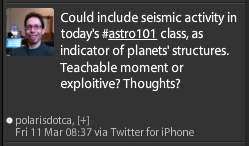Here’s a quiz for you: what’s wrong with these pictures?



Did you find anything wrong? Surely you noticed the black widow spider has only 6 legs, not 8. Here’s the original – I amputated one leg with photoshop for the pic above. If you rolled-over the pyramids picture and saw the reference to National Geographic, you might suspect the pyramids are in the wrong locations. Not in this picture, though: there’s nothing wrong it. (source)
What about the picture from the advent calendar? If you’re at all familiar with this blog and my passion for teaching astronomy, you might have guessed I’m going to tell you about the Moon and its incorrect phase.
And you’d be right.
The November 25, 2011 edition of the Guardian carried the story, “Your moons are rubbish, astronomer tells Christmas card artists.” The offending advent calendar shows the Moon in the waning crescent phase:
As astronomer Peter Barthel correctly points out, this phase rises around 3:00 am and sets around 3:00 pm. No matter if this Moon is rising, setting or somewhere in between, you’re not going to find people caroling in the town square. The artist got the wrong phase. In fact, Barthel has done much more than point out this one flawed calendar. In an article submitted to the journal Communicating Astronomy with the Public, he finds errors in artists’ depictions of the Moon in everything from Dora the Explorer to Christmas wrapping paper, from the Netherlands to North America.
The responses to the Guardian story, and its offspring like this Globe and Mail piece, seem to fall into three camps:
- “Oh, puh-lease! It’s just a picture on a calendar! Gimme break, you grinch!”
- “Oh, c’mon! Everybody know the Moon cannot be in the waning crescent phase in the evening!” (I suspect the Guardian reporter might fall into this camp because he writes, “[t]he phases of the moon are easy to grasp.” As someone who teaches astronomy and studies astronomer education, let me tell you, for the vast majority of people, they’re not.)
- “Oh, dear. Another case of scientific illiteracy.”
Me? I’m in Camp 3. Why can’t an artist do some fact-checking before drawing the Moon? Does the artist think to himself, “I wonder if that’s the right phase? Ah, screw it, whatever.” I doubt it. It’s more likely a lack of recognition that the phases of the Moon follow a predictable, understandable pattern. That is, most people don’t even realize you can ask a question like, “when does the waning crescent Moon rise?”
Or worse yet, there’s a distinct possibility that people (yes, now I’m talking about more than this one, particular artist — the problem is widespread) are completely unaware of the Moon, other than the fact that we have one. Why, just recently a colleague said to me, “I have no idea about phases. I never look at the Moon.”
Which brings me back to the six-legged spider. If you bought a book for your kid with a six-legged spider, you’d see the error. Would you draw in a two more legs? I would. Even your kid would see the error and tell you the book is rubbish. Why the difference between spiders and the Moon, then?
“Because spiders are something everyone sees every day.” Uh-huh, like the Moon.
“Because spiders are icky and gross and awesome. And the Moon is, like, science-y. Boooorrrring…” Damn.
What do I think we should do about it? I’d like people to learn some astronomy, sure. More than that, though. I want people to think scientifically. I want to live in a world where people have the awareness (and freedom) to stop and ask, “Really? Are you sure about that?”
That’s a tall order so let’s get on it. We can start by modeling scientific awareness for our kids, students, friends. Show them it’s okay to be passionate about math. Show them it’s okay to step off the sidewalk onto the grass to look at a bug or an interesting stone. Read them stories that engage their brains. Don’t buy books, wrapping paper or calendars with incorrect science. And if you accidentally do, don’t laugh it off with a “whatever…” It only takes one or two of those for kids to learn the science is dumb and only grinches point out mistakes. Instead, take the opportunity to talk with them about how we should always be curious about how things work.
A society of scientifically-literate people? That’s a world I’d like retire in.






